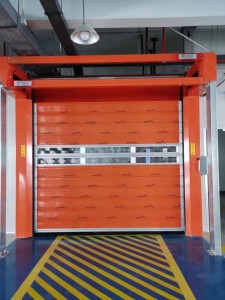How rapid doors improve the energy efficiency of door openings
Rapid doors are a common equipment in modern industrial fields and are widely used in logistics, warehousing, automobile manufacturing and other industries. Rapid doors not only have the advantages of improving work efficiency and reducing energy consumption, but also improve the energy efficiency of door openings, allowing enterprises to save resources during the production process.
To improve the energy efficiency of door openings, you first need to choose high-quality rapid doors. High-quality rapid doors have good thermal insulation and sealing properties, which can effectively reduce the conduction and exchange of indoor and outdoor temperatures and reduce energy consumption. When choosing a high-speed door, you should give priority to factors such as door body material, sealing structure and thermal insulation performance.
Secondly, the installation and maintenance of rapid doors are also the key to improving the energy efficiency of door openings. The installation of rapid doors should be carried out in strict accordance with the manufacturer’s specifications to ensure installation quality and sealing performance. At the same time, regularly inspect and maintain the seals, electrical equipment and other components of the fast door, promptly repair air leakage and water leakage, maintain good sealing of the door opening, and reduce energy waste.
In addition, the use management of rapid doors is also an important part of improving the energy efficiency of door openings. During actual use, establish reasonable opening and closing specifications to avoid frequent opening and closing of doors and reduce energy consumption. For different work areas, different opening methods and time controls can be set, and the opening and closing speed of the door can be flexibly adjusted according to actual needs to further reduce energy consumption.
While the energy efficiency of door openings is improved, other measures can be taken to further optimize energy utilization. For example, insulation facilities, such as insulation windows and insulation boards, can be installed around door openings to reduce energy transmission and loss. In addition, natural light and ventilation should be rationally utilized to reduce the need for artificial lighting and mechanical ventilation, further improving energy efficiency.
In short, improving the energy efficiency of door openings requires comprehensive consideration of the quality, installation and maintenance, usage management and other aspects of fast doors. Only by starting from multiple links and taking comprehensive measures can we minimize energy consumption and achieve the goal of sustainable development. Rapid doors are a common equipment in modern industrial fields and are widely used in logistics, warehousing, automobile manufacturing and other industries. Rapid doors not only have the advantages of improving work efficiency and reducing energy consumption, but also improve the energy efficiency of door openings, allowing enterprises to save resources during the production process.
To improve the energy efficiency of a door opening, you first need to choose a high-quality rapid door. High-quality rapid doors have good thermal insulation and sealing properties, which can effectively reduce the conduction and exchange of indoor and outdoor temperatures and reduce energy consumption. When choosing a high-speed door, you should give priority to factors such as door body material, sealing structure and thermal insulation performance.
Secondly, the installation and maintenance of rapid doors are also the key to improving the energy efficiency of door openings. The installation of rapid doors should be carried out in strict accordance with the manufacturer’s specifications to ensure installation quality and sealing performance. At the same time, regularly inspect and maintain the seals, electrical equipment and other components of the fast door, promptly repair air leakage and water leakage, maintain good sealing of the door opening, and reduce energy waste.
In addition, the use management of rapid doors is also an important part of improving the energy efficiency of door openings. During actual use, establish reasonable opening and closing specifications to avoid frequent opening and closing of doors and reduce energy consumption. For different work areas, different opening methods and time controls can be set, and the opening and closing speed of the door can be flexibly adjusted according to actual needs to further reduce energy consumption.
While the energy efficiency of door openings is improved, energy utilization can also be further optimized through other measures. For example, insulation facilities, such as insulation windows and insulation boards, can be installed around door openings to reduce energy transmission and loss. In addition, natural light and ventilation should be rationally utilized to reduce the need for artificial lighting and mechanical ventilation, further improving energy efficiency.
In short, improving the energy efficiency of door openings requires comprehensive consideration of the quality, installation and maintenance, usage management and other aspects of fast doors. Only by starting from multiple links and taking comprehensive measures can we minimize energy consumption and achieve the goal of sustainable development.
